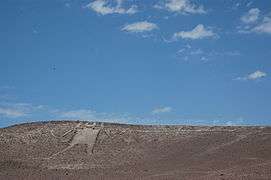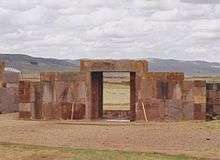Atacama Giant
Coordinates: 19°56′56″S 69°37′59″W / 19.94889°S 69.63306°W


The Atacama Giant (Spanish: Gigante de Atacama) is a large anthropomorphic geoglyph in the Atacama Desert, Chile.[1] Located at "Cerro Unitas", this is the largest prehistoric anthropomorphic figure in the world with a height of 119 metres (390 ft) and represents a deity for the local inhabitants from AD 1000 to 1400.
The figure was an early astronomical calendar for knowing where the moon would set; by knowing this the day, crop cycle, and season could be determined. The points on the top and side of the head would say what season it would be depending on their alignment with the moon, which was very important in determining when the rainy season would come in the barren Atacama.
Geoglyphs of Chile
The Atacama Giant is one out of nearly 5,000 geoglyphs - ancient artwork that are drawn into the landscape - that have been discovered in the Atacama in the last three decades.[2] Although geoglyphs have always been the subject of wild conjectures and bizarre theories, it is now widely believed that they are the work of several successive cultures that dwelt in this region of South America, including the Tiwanaku and Inca.

References
- ↑ "Geoglyphs of Earth". Blue Knight Productions. Retrieved 24 January 2013.
- ↑ Hirst, K. Kris. "The Geoglyphic Art of Chile's Atacama Desert Messages, Memories and Rites of the Landscape". about.com. Retrieved 24 January 2013.